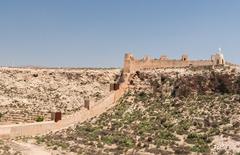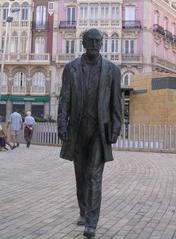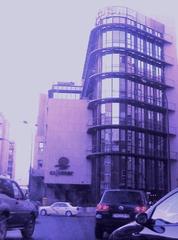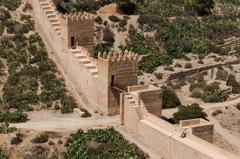Molina del Cortijo de Las Norias de San Antonio: Visiting Hours, Tickets, and Travel Guide
Date: 14/06/2025
Introduction
Nestled in the agricultural heart of Almería, Spain, the Molina del Cortijo de Las Norias de San Antonio stands as a testament to centuries of rural innovation and resilience. This historic hydraulic mill—set within the Campo de Dalías and near the Parque Natural de Cabo de Gata-Níjar—embodies the enduring relationship between human ingenuity and the Mediterranean environment. Visitors can explore the molina, a traditional water-lifting noria historically powered by animal traction, and the cortijo, a rural estate central to agricultural life. These remarkable structures reflect both architectural adaptation to the local climate and the deep cultural heritage of Andalusia.
Whether you are a history buff intrigued by Islamic-era engineering, a nature lover drawn to unique wetlands, or a cultural traveler seeking authentic Andalusian experiences, this guide provides essential insights on the site’s history, visiting hours, ticketing, accessibility, and nearby attractions. Given the agricultural use and private ownership of many molinas and cortijos, access is often via guided tours arranged through local tourism offices such as those in El Ejido or at visitor centers in Amoladeras and Rodalquilar. The best times to visit are spring and autumn, when the weather is mild and the landscape at its most vibrant.
This guide synthesizes information from authoritative sources—including the Andalusian Historical Heritage Catalog and local environmental organizations—to enrich your visit with practical details and cultural context (Junta de Andalucía, 2001; Conoce Tus Fuentes; SEO/BirdLife; Academia.edu).
Table of Contents
- Introduction
- Historical Background
- Interdependence and Evolution
- Visiting Information
- Nearby Attractions
- Conservation and Sustainable Tourism
- Cultural Significance
- FAQs
- Planning Your Visit
- Resources and Contacts
- Conclusion
- References
Historical Background
The Molina: Water Management and Rural Ingenuity
Originating in the Islamic period (8th–15th centuries), the molinas of Almería were vital to lifting scarce groundwater for irrigation in this semi-arid region (Academia.edu). Early models were constructed from wood, with later versions incorporating iron. These devices supported sophisticated irrigation systems—acequias (canals), balsas (ponds)—enabling year-round agriculture.
The Cortijo: Agricultural Estates and Community Life
The cortijo, or rural estate, served as the organizational center for land, labor, and water resources. Constructed from climate-adapted materials like adobe, stone, and lime, cortijos ranged from modest family farms to large estates and were often located near molinas or wells (Conociendo Níjar). These estates were the backbone of rural community life and economic activity.
Interdependence and Evolution
Molinas and cortijos were deeply interdependent. Water drawn by molinas irrigated the fields managed by cortijos, supporting a diversity of crops and livestock. Over time, technological advances—such as electric pumps and greenhouse agriculture—transformed the agricultural landscape. While many traditional structures fell into disuse, some have been restored for heritage and tourism purposes (Academia.edu).
Visiting Information
Hours, Tickets, and Accessibility
- Visiting Hours: Most molinas and cortijos do not operate as formal museums and are located on private or working agricultural land. Guided tours typically take place between 9:00 AM and 6:00 PM; always confirm availability in advance.
- Tickets: Access is usually free for outdoor areas; guided tours may charge €15–€30 per person.
- Accessibility: Terrain is often uneven and pathways unpaved. Comfortable footwear is recommended, and visitors with mobility concerns should inquire with the tourism office about accessibility.
Guided Tours and Activities
Guided tours are available through local tourism offices (e.g., Oficina de Turismo de El Ejido) and visitor centers in Amoladeras and Rodalquilar. These tours offer insights into hydraulic engineering, traditional agriculture, and rural heritage. Seasonal events and educational workshops are sometimes held in conjunction with local festivals.
Directions
- By Car: The site is accessible via the A-7 motorway, exiting at “El Ejido – Las Norias,” then following local roads AL-3303 and AL-3304 (Google Maps).
- By Public Transport: Limited regional bus service is available; a private car or taxi is recommended.
- Parking: Available roadside near the site.
Nearby Attractions
- Balsa del Sapo: A reclaimed irrigation lagoon now serving as a wetland habitat for endangered birds (SEO/BirdLife).
- Las Norias de Daza: Explore the agricultural village and its vibrant markets, set amid the famous “sea of plastic” greenhouses (El País article).
- Almerimar: A modern coastal resort with a marina, golf course, and beaches (Almerimar Turismo).
- Punta Entinas-Sabinar Nature Reserve: Protected dunes and marshes, home to over 200 bird species (Junta de Andalucía).
- El Ejido Town: Cultural events, shops, and the Archaeological Museum (Festival de Teatro).
- Almería City: Explore the Alcazaba, Cathedral, and a lively tapas scene (Official Tourism Site).
Conservation and Sustainable Tourism
Restoration projects are ongoing, focusing on preserving Andalusia’s rural heritage and encouraging sustainable tourism (Choose Almeria). Some cortijos have been adapted as rural guesthouses or cultural centers. Respect local guidelines, avoid trespassing, and support conservation by following marked paths and participating in guided tours.
Cultural Significance
Molinas and cortijos symbolize centuries of human adaptation, reflecting both the region’s Islamic heritage and later innovations. They are recognized by the Andalusian Historical Heritage Catalog as protected sites (Junta de Andalucía, 2001), and remain integral to local identity and tradition.
Frequently Asked Questions (FAQs)
Q: What are the visiting hours?
A: Typically, between 9:00 AM and 6:00 PM by guided tour; check with local visitor centers for updates.
Q: Is there an entrance fee?
A: Outdoor areas are generally free to visit; guided tours may have a nominal fee.
Q: Are guided tours available?
A: Yes, through local tourism offices and during special events.
Q: Is the site accessible for those with mobility issues?
A: Some terrain is uneven; check in advance with the tourism office for specific arrangements.
Q: When is the best time to visit?
A: Spring and autumn offer the most comfortable weather and vibrant landscapes.
Planning Your Visit
- Best Time: October–May for mild weather and fewer agricultural activities.
- What to Bring: Sun protection, water, snacks, and a camera.
- Etiquette: Respect private property, avoid disturbing ongoing agriculture, and follow posted guidelines.
- Transportation: Renting a car is advisable for flexibility.
- Language: Spanish is predominant; basic phrases or a translation app are useful.
Resources and Contacts
- Oficina de Turismo de El Ejido
- Ayuntamiento de El Ejido
- Junta de Andalucía – Espacios Naturales
- SEO/BirdLife – Balsa del Sapo
- Conoce Tus Fuentes
- Guía Turístico José Antonio
Conclusion
The Molina del Cortijo de Las Norias de San Antonio offers a window into Almería’s agricultural history and the ongoing story of rural resilience. From its historic hydraulic mill to nearby wetlands and vibrant towns, the region invites visitors to explore a unique blend of tradition, nature, and culture. Plan your visit with the help of local guides, respect the fragile heritage, and experience the enduring legacy of Andalusia’s countryside.
Ready for more? Download the Audiala app for interactive maps and guided tours, and follow us on social media for the latest news on Almería’s heritage sites.
References
- Study of wetland evolution in a semiarid region using GIS: Case of Cañada de Las Norias, Campo de Dalías, SE Spain, 2023, Academia.edu
- Historical Heritage Catalog of Andalusia, 2001, Junta de Andalucía
- Molina del Cortijo de Las Norias de San Antonio, Conoce Tus Fuentes
- Cabo de Gata Natural Park and Rural Tourism, Choose Almeria
- Balsa del Sapo Wetland Information, SEO/BirdLife



